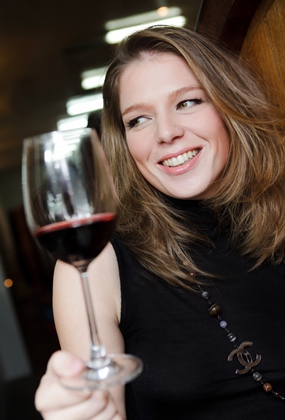Now listen, I promise that I’m not going to enter the realm of wine geeks and wine snobs here, but there’s something you need to know – if you don’t know already. And it’s this: the drinking temperature of wine is really important. It’s true, believe me. One of the biggest mistakes people make with wine is consuming it too cold or more often, too warm. Even the cheapest wines taste better at the right temperature. If wine is too cold, the aromas stay hidden and the taste feels tight and closed. Cold reds can taste tannic and unpleasant. Wines taste flabby when they’re too warm because they lose their refreshing qualities and firmness of body. Forget the old nonsense about serving reds at room temperature, for in this climate it simply doesn’t apply.
Some wine producers give recommended drinking temperatures on their wine labels but when they don’t, I’d suggest that you drink full-bodied whites at around 11°C; light whites around 9°C and sweet wines at 6°-7°C. Reds are usually best between 12-17°C with the lighter ones at the lower temperatures. Now this is all very well, but to keep the wine at these temperatures when the average room is about 32°C is something of a challenge. In this tropical climate, there can be a huge difference in temperature between the moment the wine is poured and the moment you taste it.
 Kathrin Puff, “Monsoon Valley” Winemaker
Kathrin Puff, “Monsoon Valley” Winemaker
Have you any idea how quickly a glass of wine warms up around here? Well, I didn’t until the other day when I conducted my Wine Temperature Experiment in the kitchen, much to the merriment of the dogs. I took a white wine out of the fridge and checked the temperature with a digital thermometer. It was exactly 3°C and probably a bit too cold for drinking. Some of the wine was poured into a decanter and the bottle shoved back in the fridge. A sample was then poured into a wine glass. During this process, which took a couple of minutes the wine’s temperature shot up to 10° C, which as it turns out, is just about right for drinking lighter whites.
But then, the big surprise. In the following five minutes when the glass was left unattended, the temperature increased to an amazing 15°C. Of course, at this temperature the wine was too warm to drink. It was heating up at a staggering one degree Celsius every minute – or roughly two degrees Fahrenheit. At a social occasion, the wine could be too warm before you get to taste it, let alone get to the end of the glass, especially if people insist of doing the “chok dee” routine before every swig. I should add that the experiment was conducted with the air-conditioners switched off, because being half Scottish I tend to avoid reckless spending.
Anyway, if you think I made all that up, you can try the experiment for yourself if you have the time and the inclination. All you need is a fridge, some wine and a wine glass, a kitchen timer and a digital thermometer. If you can manage to borrow a white laboratory coat, the experiment will look a bit more impressive. And try not to drink the wine.
Monsoon Valley White Shiraz 2012, Thailand (Bt. 650 @ various outlets)
Monsoon Valley wines come from Hua Hin Hills Vineyard where the vines are cooled by the ocean breezes wafting in from the Gulf of Thailand. This white Shiraz, like most other wines of this type, is not white at all but is actually a light salmon-pink with a faint tinge of orange. It really looks inviting and to my mind that’s important. So that’s your first little treat. For the second one, swirl the wine around then get your nose into the glass. Unless you’ve got a cold or there’s something wrong with your nose, you should get a lovely aroma of strawberries with other red berry fruits in the background. Another sniff might bring you a hint of delicate pepper.
For your third treat, have a slow and thoughtful taste. You’ll feel the smooth texture of the wine straight away and then the attractive light and refreshing fruity taste. There’s also a really crisp tang of perky acidity and a long, dry and fruity finish with hints of light tannin. I find this wine rather charming. The last few vintages have won a cart-load of awards, so it’s clearly doing very well on the international scene. This vintage for example, has already won Bronze Medals at the Hong Kong International Wine & Spirit Competition; the Japan Wine Challenge and the UK’s Decanter World Wine Awards.
Monsoon Valley Chenin Blanc Medium Sweet 2012 (white), Thailand (Bt. 650 @ various outlets)
This light golden wine has an aroma of gooseberries, apple, honey and other fruits. There’s a very soft mouth-feel and you’ll notice immediately the ripe but elegant sweetness. There’s plenty of gooseberry fruit on the palate too; a hint of honey and a spritzy tang of gentle acidity. The wine has a sweet, slightly floral finish and I thought I could pick up a taste of raisins too. The fruit, sweetness and acidity are perfectly balanced and in many ways this is a rather charming easy drinker with a touch of class. I’d be quite happy to swig this most of the evening because it’s only a modest 9% alcohol content. It also won a Bronze Medal at the Decanter Asia Awards held in China last year. To my mind, this is a wine that needs to be served as cold as you can to bring out the refreshing spritzy quality.
All of which brings us back to my not-very-scientific experiment. For white wines, I think the answer is this. If you don’t use a decanter, keep the bottle in the fridge until the very last moment before you pour the wine. Then shove the bottle into an ice bucket. Alternatively, pour the wine into a cold decanter and leave it in the fridge until needed. Either way, serve the wine in cool glasses, but don’t get them so cold that your guests drop them in shock.




